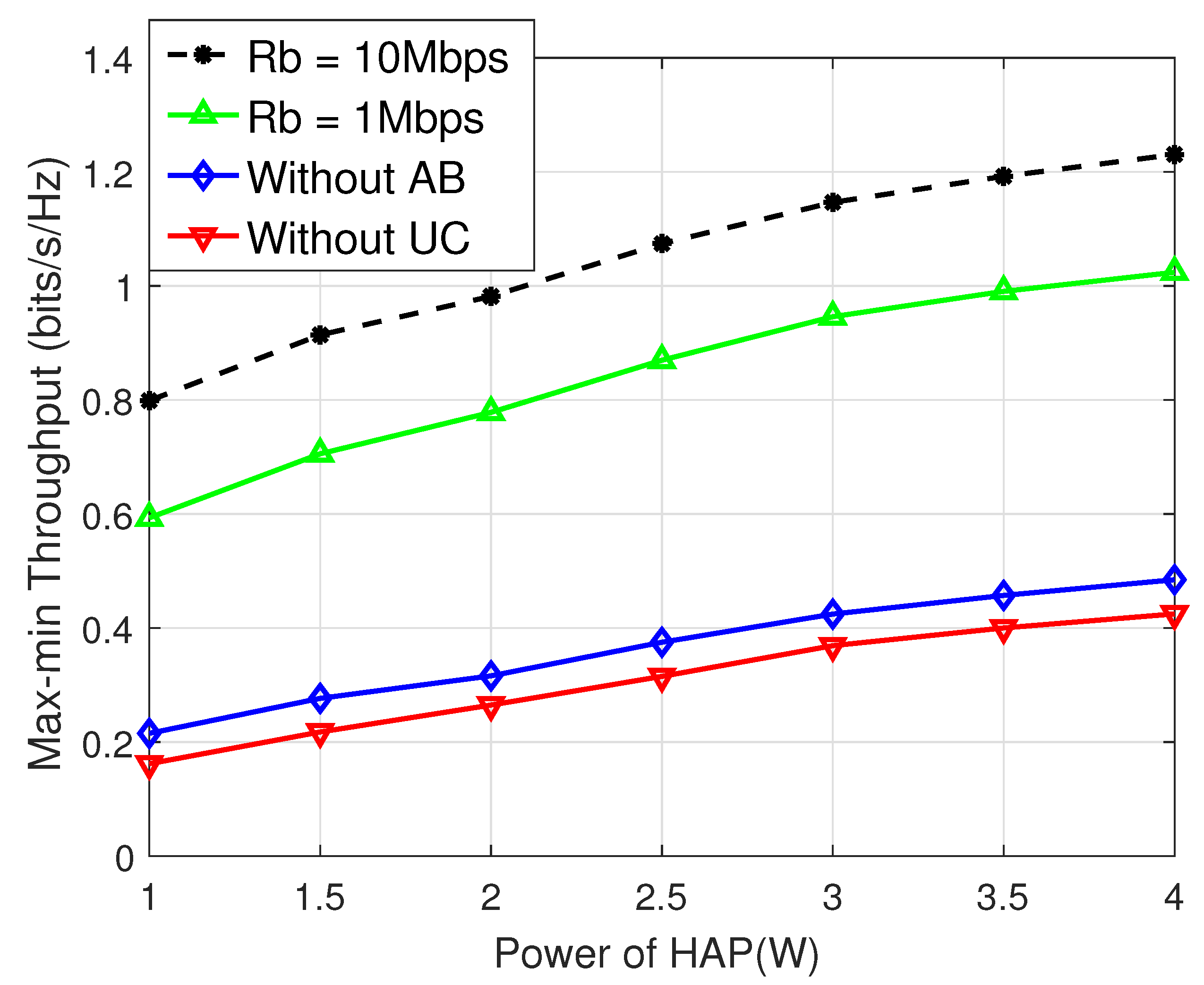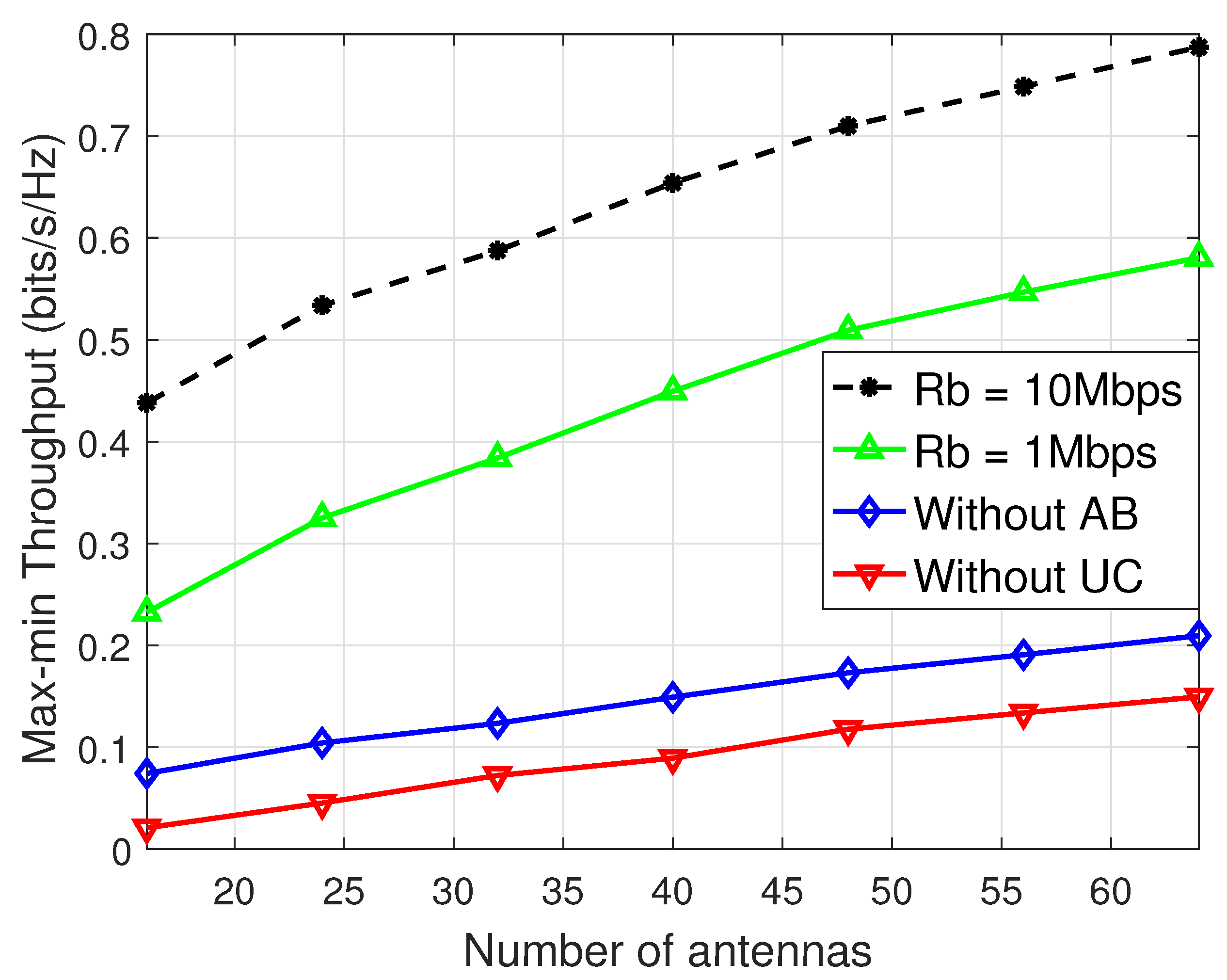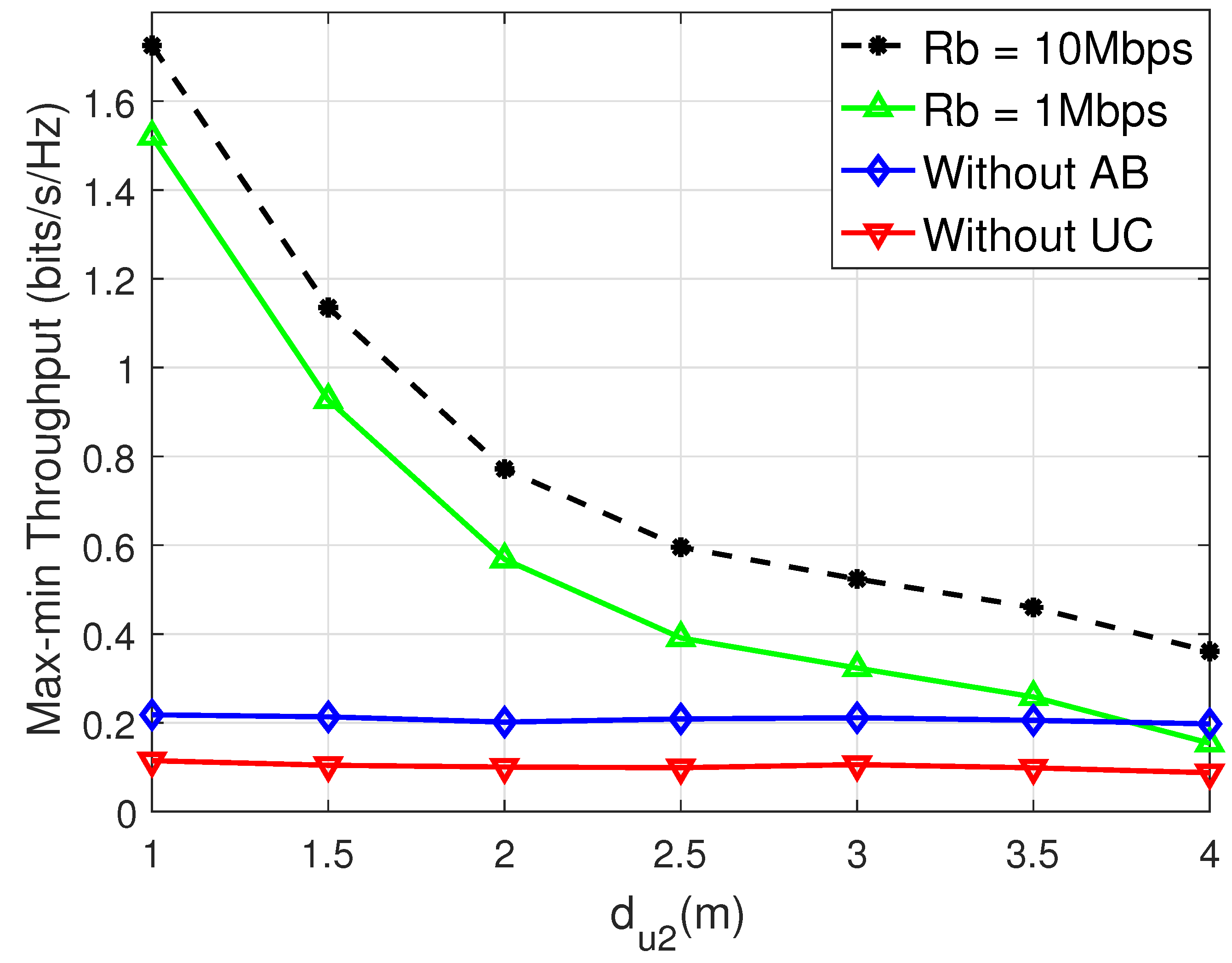Ambient Backscatter-Based User Cooperation for mmWave Wireless-Powered Communication Networks with Lens Antenna Arrays
Abstract
:1. Introduction
1.1. Motivation
1.2. Related Work
1.3. Our Contributions
1.4. Notation and Paper Organization
2. System Model and Problem Formulation
2.1. Channel Model
2.2. The Protocol Description
2.3. Problem Formulation
3. Problem Transformation
4. Simulation Results
5. Conclusions
Author Contributions
Funding
Data Availability Statement
Conflicts of Interest
References
- Latva-Aho, M.; Leppanen, K. Key Drivers and Research Challenges for 6G Ubiquitous Wireless Intelligence; University of Oulu: Oulu, Finland, 2019; White Paper 1; Available online: http://urn.fi/urn:isbn:9789526223544 (accessed on 9 September 2019).
- You, X.; Wang, C.X.; Huang, J.; Gao, X.; Zhang, Z.; Wang, M.; Huang, Y.; Zhang, C.; Jiang, Y.; Wang, J.; et al. Towards 6G wireless communication networks: Vision, enabling technologies, and new paradigm shifts. Sci. China Inf. Sci. 2021, 64, 110301. [Google Scholar] [CrossRef]
- Guo, R.; Tang, Y.; Zhang, C.; Liu, S.; Zhao, Z. Prospects and Challenges of THz Precoding. Chin. J. Electron. 2022, 31, 488–498. [Google Scholar] [CrossRef]
- Alsabah, M.; Naser, M.A.; Mahmmod, B.M.; Abdulhussain, S.H.; Eissa, M.R.; Al-Baidhani, A.; Noordin, N.K.; Sait, S.M.; Al-Utaibi, K.A.; Hashim, F. 6G Wireless Communications Networks: A Comprehensive Survey. IEEE Access 2021, 9, 148191–148243. [Google Scholar] [CrossRef]
- Zeng, Y.; Clerckx, B.; Zhang, R. Communications and signals design for wireless power transmission. IEEE Trans. Commun. 2017, 65, 2264–2290. [Google Scholar] [CrossRef]
- Yang, G.; Zhang, Q.; Liang, Y.C. Cooperative ambient backscatter communication systems for future internet-of-things. IEEE Internet Things J. 2018, 5, 1116–1130. [Google Scholar] [CrossRef]
- Zhong, S.; Wang, X. Transmission scheduling for hybrid backscatter-HTT nodes. IEEE Internet Things J. 2021, 8, 1769–1782. [Google Scholar] [CrossRef]
- Di, X.; Xiong, K.; Fan, P.; Yang, H.-C.; Letaief, K.B. Optimal resource allocation in wireless powered communication networks with user cooperation. IEEE Trans. Wirel. Commun. 2017, 16, 7936–7949. [Google Scholar] [CrossRef]
- Zheng, Y.; Bi, S.; Zhang, Y.J.; Quan, Z.; Wang, H. Intelligent reflecting surface enhanced user cooperation in wireless powered communication networks. IEEE Wirel. Commun. Lett. 2020, 9, 901–905. [Google Scholar] [CrossRef]
- Ahmed, A.M.; Wang, Z.; Belay, H.T.; Wan, X. Energy-Efficient Optimization for WPCN System Based on User Cooperation. In Proceedings of the 2022 27th Asia Pacific Conference on Communications (APCC), Jeju Island, Republic of Korea, 19–21 October 2022; pp. 329–333. [Google Scholar]
- Lu, X.; Niyato, D.; Jiang, H.; Kim, D.I.; Xiao, Y.; Han, Z. Ambient backscatter assisted wireless powered communications. IEEE Wirel. Commun. 2018, 25, 170–177. [Google Scholar] [CrossRef]
- Zhuang, Y.; Li, X.; Ji, H.; Zhang, H.; Leung, V.C.M. Optimal resource allocation for RF-powered underlay cognitive radio networks with ambient backscatter communication. IEEE Trans. Veh. Technol. 2020, 69, 15216–15228. [Google Scholar] [CrossRef]
- Zhuang, Y.; Li, X.; Ji, H.; Zhang, H. Exploiting hybrid SWIPT in ambient backscatter communication-enabled relay networks: Optimize power allocation and time scheduling. IEEE Internet Things J. 2022, 9, 24655–24668. [Google Scholar] [CrossRef]
- Liu, Z.; Zhao, S.; Yang, Y.; Ma, K.; Guan, X. Toward hybrid backscatter-aided wireless-powered Internet of Things networks: Cooperation and coexistence scenarios. IEEE Internet Things J. 2022, 9, 6264–6276. [Google Scholar] [CrossRef]
- Yang, C.; Wang, X.; Chin, K.-W. On max-min throughput in backscatter-assisted wirelessly powered IoT. IEEE Internet Things J. 2020, 7, 137–147. [Google Scholar] [CrossRef]
- Hu, Y.; Wang, P.; Lin, Z.; Ding, M.; Liang, Y. Performance Analysis of Ambient Backscatter Systems with LDPC-Coded Source Signals. IEEE Trans. Veh. Technol. 2021, 70, 7870–7884. [Google Scholar] [CrossRef]
- Khan, T.A.; Alkhateeb, A.; Heath, R.W. Millimeter wave energy harvesting. IEEE Trans. Wirel. Commun. 2016, 15, 6048–6062. [Google Scholar] [CrossRef]
- Khan, T.A.; Heath, R.W. Wireless power in millimeter wave tactical networks. IEEE Signal Process. Lett. 2017, 24, 1284–1287. [Google Scholar] [CrossRef]
- Tran, T.X.; Wang, W.; Luo, S.; Teh, K.C. Nonlinear energy harvesting for millimeter wave networks with large-scale antennas. IEEE Trans. Vehi. Technol. 2018, 67, 9488–9498. [Google Scholar] [CrossRef]
- Psomas, C.; Krikidis, I. Energy beamforming in wireless powered mmWave sensor networks. IEEE J. Sel. Areas Commun. 2019, 37, 424–438. [Google Scholar] [CrossRef]
- Kwon, G.; Park, H.; Win, M.Z. Joint beamforming and power splitting for wideband millimeter wave SWIPT systems. IEEE J. Sel. Top. Signal Process. 2021, 15, 1211–1227. [Google Scholar] [CrossRef]
- Guo, R.; Zhao, M.; Zhao, M. Joint Transceiver Design for Decoupled Full-Duplex Wireless Powered Communication Networks with Lens Antenna Arrays. In Proceedings of the 10th International Conference on Wireless Communications and Signal Processing (WCSP 2018), Hangzhou, China, 18–20 October 2018; pp. 1–6. [Google Scholar]
- Guo, R.; Cai, Y.; Zhao, M.; Shi, Q.; Champagne, B.; Hanzo, L. Joint Design of Beam Selection and Precoding Matrices for mmWave MU-MIMO Systems Relying on Lens Antenna Arrays. IEEE J. Sel. Top. Signal Process. 2018, 12, 313–325. [Google Scholar] [CrossRef]
- Guo, R.; Cai, Y.; Shi, Q.; Zhao, M.; Champagne, B. Joint design of beam selection and precoding for mmWave MU-MIMO systems with lens antenna array. In Proceedings of the IEEE 28th Annual International Symposium on Personal, Indoor, and Mobile Radio Communications (PIMRC), Montreal, QC, Canada, 8–13 October 2017; pp. 1–5. [Google Scholar]
- Abeywickrama, S.; You, C.; Zhang, R.; Yuen, C. Channel Estimation for Intelligent Reflecting Surface Assisted Backscatter Communication. IEEE Wirel. Commun. Lett. 2021, 10, 2519–2523. [Google Scholar] [CrossRef]
- CVX Research, Inc. CVX: Matlab Software for Disciplined Convex Programming, Version 2.0 beta. Available online: http://cvxr.com/cvx (accessed on 1 September 2013).
- Zeng, Y.; Zhang, R. Cost-effective millimeter-wave communications with lens antenna array. IEEE Wirel. Commun. 2017, 24, 81–87. [Google Scholar] [CrossRef]
- Gao, X.; Dai, L.; Chen, Z.; Wang, Z.; Zhang, Z. Near-optimal beam selection for beamspace mmWave massive MIMO systems. IEEE Commun. Lett. 2016, 20, 1054–1057. [Google Scholar] [CrossRef]





Disclaimer/Publisher’s Note: The statements, opinions and data contained in all publications are solely those of the individual author(s) and contributor(s) and not of MDPI and/or the editor(s). MDPI and/or the editor(s) disclaim responsibility for any injury to people or property resulting from any ideas, methods, instructions or products referred to in the content. |
© 2024 by the authors. Licensee MDPI, Basel, Switzerland. This article is an open access article distributed under the terms and conditions of the Creative Commons Attribution (CC BY) license (https://creativecommons.org/licenses/by/4.0/).
Share and Cite
Guo, R.; Yin, R.; Wang, G.; Xu, C.; Yuan, J. Ambient Backscatter-Based User Cooperation for mmWave Wireless-Powered Communication Networks with Lens Antenna Arrays. Electronics 2024, 13, 3485. https://doi.org/10.3390/electronics13173485
Guo R, Yin R, Wang G, Xu C, Yuan J. Ambient Backscatter-Based User Cooperation for mmWave Wireless-Powered Communication Networks with Lens Antenna Arrays. Electronics. 2024; 13(17):3485. https://doi.org/10.3390/electronics13173485
Chicago/Turabian StyleGuo, Rongbin, Rui Yin, Guan Wang, Congyuan Xu, and Jiantao Yuan. 2024. "Ambient Backscatter-Based User Cooperation for mmWave Wireless-Powered Communication Networks with Lens Antenna Arrays" Electronics 13, no. 17: 3485. https://doi.org/10.3390/electronics13173485





